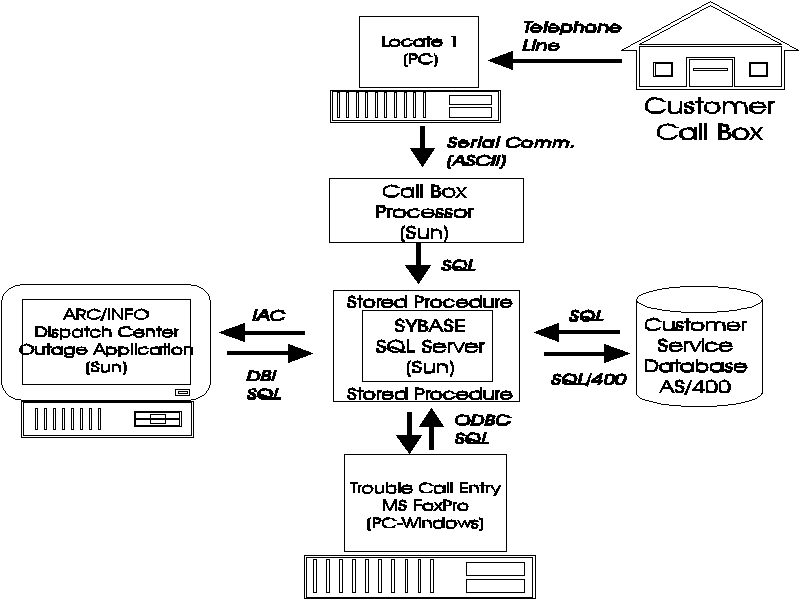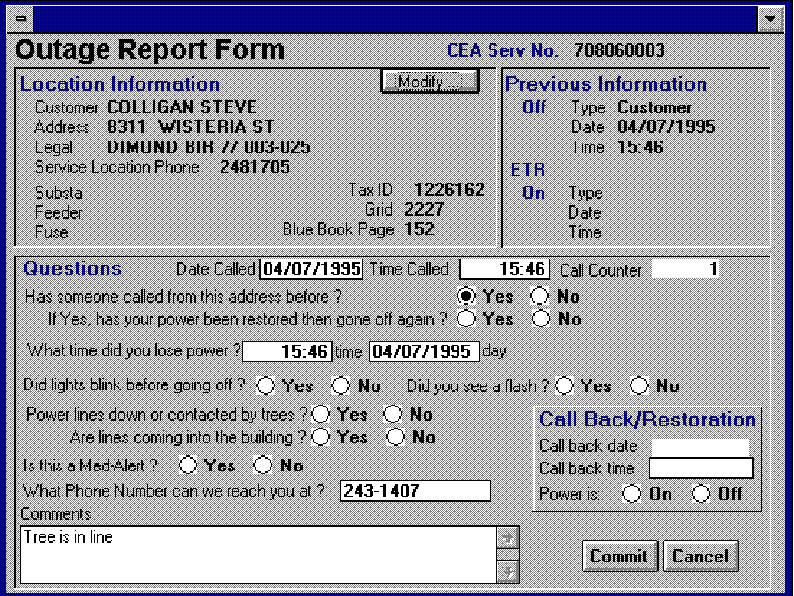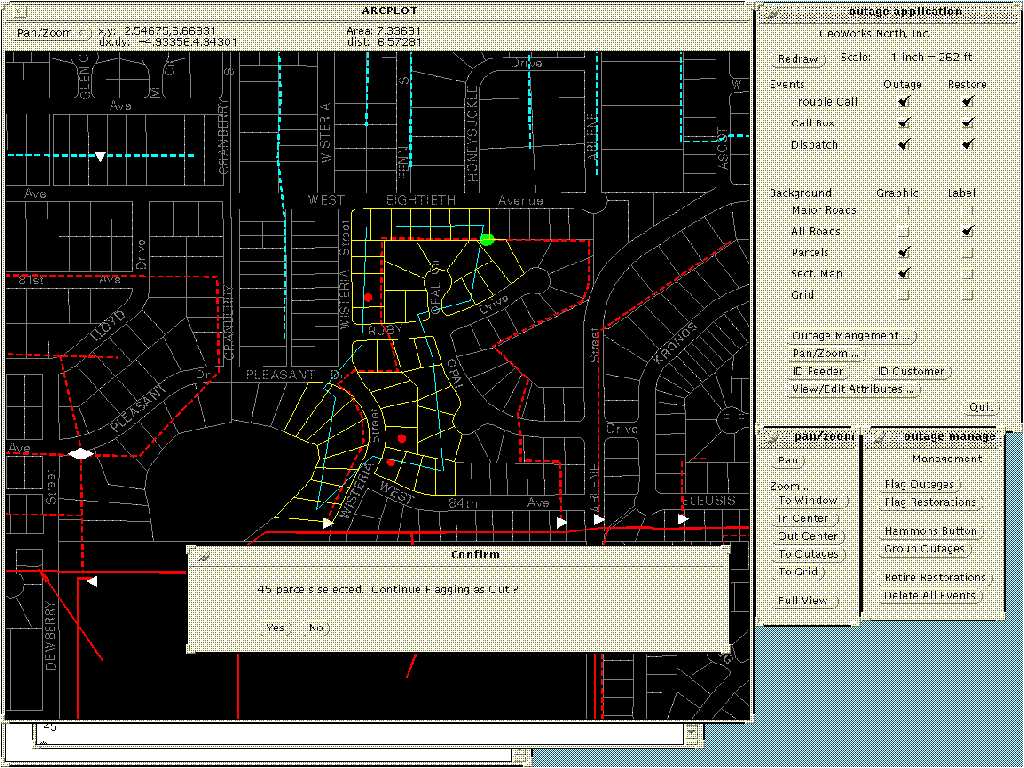Chugach Electric Association and GeoWorks North, Inc. (Anchorage, Alaska) recently completed a Real Time Outage/Trouble Call system using ArcInfo. This system provides an important and tangible `incremental victory' because the system is operational before completion of full GIS conversion and the establishment of connectivity for all conductors and equipment. The system makes use of inexpensive ($40) Call Box units located in customer's houses that automatically telemeter outage and restoration information to Chugach's dispatch center. This information is supplemented by outage information from Trouble Calls (customers calling in), as well as information from Chugach customer service database stored in SYBASE. Outage and Restoration information is automatically mapped on a large projection display in the dispatch center using ArcInfo's Inter-Application Communication (IAC) capabilities. Dispatchers can graphically query outages, flag areas known to be outaged, flag restorations, print statistics, and view system schematics superimposed on top of outage information.
Electric Utilities beginning the implementation of GIS face the challenge of embarking on an expensive and time- consuming conversion and application development process. GIS Managers are often frustrated because they typically have little or no usable product (to show what they have been doing with all this time and money) until the entire process is completed. Chugach Electric Association (Chugach) and GeoWorks North, Inc. in Anchorage, Alaska have completed a GIS-based Outage Management Application, and the system is being used well before completion of a full GIS conversion and SCADA integration. The system makes maximum use of existing data sources, as well as new functions within ArcInfo to display real time outage and restoration information. Inexpensive outage reporting devices were installed in consumers homes to rapidly telemeter supplemental outage information to the system. This `incremental victory' is directly applicable to other Electric Utilities, since most utilities have the same basic building blocks used by the Chugach system.
Chugach is in the process of performing a full GIS conversion and acquiring a new SCADA/Energy Management System (EMS). Managers realized that these systems would take several years to develop and recent major storms in the Anchorage area pointed out deficiencies in the existing distribution trouble call analysis and outage reporting procedures which would need to be addressed immediately. During strategy sessions, it became apparent that a very functional Outage Management Application could be developed immediately, with the potential for expanding the system once the full GIS conversion and SCADA/EMS where functional.
The bulk of the time and effort involved in a full GIS conversion is establishing the attributes and connectivity of field equipment and devices. Utilities usually can rapidly establish spatial locations from existing digital maps, or by scanning and vectorizing hard-copy maps. The coding of attributes, and ensuring connectivity is established to model the system, however, represents a significant effort. Chugach was able to rapidly develop its Outage Management Application because it does not (at this stage) require connectivity. After the full GIS conversion, connectivity will exist to allow dispatchers to trace from a house back to the transmission system. In the meantime, however, Chugach has a functional tool for mapping and managing outages which is much more efficient and effective than the previous method for handling outages.
Prior to the new Outage Management Application, all outage reporting and trouble call analysis at Chugach was performed manually. During the beginning of a major outage, calls would reach the power control center and would be answered by a dispatcher. If it was determined that the outages were becoming widespread and the Dispatchers could no longer answer the incoming customer calls, phone help would be called in to assist. Information from incoming calls was recorded on paper forms. The information included customer name, address, telephone number, time of outage and various pieces of information which might assist a dispatcher in determining the cause of the outage. These forms then had to be completed by others with information such as legal descriptions (subdivision lot and block), and corresponding grid map numbers obtained from a separate cross reference (taxi maps), again on paper.
Once trouble call forms were completed they would then be sorted by grid. A dispatcher would then begin reviewing the stacks of forms in order to prioritize the dispatching of crews for power restoration. After sorting and prioritization was done, calls could then be correlated to paper maps of the distribution facilities in order to determine the most likely equipment failure. Crews would be dispatched with outage addresses and report back upon restoration of service. Additional addresses within a grid were given to the crew until all outages within a grid had been restored. Crews would then stand by while customers were called back to verify power had been restored.
There were many inefficiencies and problems associated with the prior method of outage reporting and trouble call analysis:
The project began in the mid-1994 as a joint effort between Power Control, Engineering (facilities mapping), and Information Services (customer information). During initial stages of the project it became apparent that the GIS and Trouble Call Analysis/Outage Reporting System could be integrated with several replacement SCADA/EMS systems being evaluated by Chugach at the time. While this posed additional integration challenges, the approach seemed to be the best solution. The system would combine most corporate computer resources into a fully integrated system; Customer Service information, GIS mapping information, Trouble call information, and real-time power system information.
A steering committee was established with members selected from Information services, Power Control, Customer Service, Customer Relations, Engineering, and Communications (SCADA/EMS) to oversee the coordination effort and resolve technical and logistical issues.
With a commitment being made to automate Trouble Call Analysis/Outage Reporting in 1994, and the new SCADA/EMS system not scheduled to be on line until mid 1996, the challenge was to implement an interim Trouble Call Analysis/Outage Reporting System containing the majority of the required functionality, while retaining most major functional elements for future integration. With this in mind, the following objectives were established for implementation of the interim system:
Due to time and budget constraints, the project needed to be produced using Chugach’s existing equipment and software to the greatest extent possible. This included the following:
In addition to entry of trouble calls Chugach decided to purchase a `Outage Call Box' system from Scientific Atlanta (SA) that would automatically report outage and restoration information from certain customer’s homes. The SA Call Boxes are inexpensive devices (approximately $40) that are plugged into a consumers electrical outlet. When power is lost or restored, the Call Box dials a preprogrammed telephone number to signal status. The Automatic Number Identification (ANI) code received via the 1-800 system allows identification of the particular Call Box that responded. This system provides a relatively inexpensive and powerful supplement to Trouble Call information. Chugach intends to place Call Boxes in two homes on each line section which are served from separate transformers. By doing this the dispatcher can determine which fuse or sectionalizing device has operated. The second Call Box on each line is necessary to distinguish single home outages (or unplugging the device) from line outages.
In order to provide viewing capabilities of outage information to all dispatch personnel, Chugach also purchased a large (120") rear projection display system. The unit is self contained and portable, so remodeling of the control center was not required. The display system is interfaced to the Sun workstations and PCs in the control center.
The project team, after evaluating several alternatives, settled on a design that attempted to make the best possible use of each technology's strongest features. In order to meet time constraints and simplify project management the project was broken up into a series of specific tasks based on the defined functional requirements. By doing this system development consisted of smaller more manageable tasks which could be performed by several working groups simultaneously, with each group having clearly defined accountabilities. This also simplified tracking progress of the project.

The major tasks necessary for completion of the system included:
To assist the dispatcher in analysis, three distinct types of outages were established : 1) Trouble Call Outages, 2) Call Box Outages, and 3) Dispatch Flagged Outages. Each type of outage is received and handled as described below.
Trouble Call outages are created by when customers call Chugach to report loss of power. An application was developed in Microsoft FoxPro for Windows that allows operators to rapidly search by customer name, address, phone number or customer number to find the proper customer record. A screen is then presented which allows the operator to ask for pertinent pieces of information, and then ’Commit’ the information. When the record is committed, an outage record is created in the SYBASE tables using Microsoft’s Open DataBase Connectivity (ODBC) standard, and ArcInfo’s Inter Application Communication (IAC) is used to optionally refresh the dispatcher’s map to show the outage. When the dispatcher flags an area as being restored, Trouble Call outages are automatically inserted into a queue of customers to be called back. The FoxPro application allows operators to page through the queue, perform the call back, and verify power restorations.

Call Box outages are created when the Scientific Atlanta Call Boxes dial the pre-programmed Chugach numbers. An interface application (written in C) residing on the SUN workstation monitors serial data received from the PC-based Scientific Atlanta call processor. The application transfers the phone number, date, time, and status (on or off) to SYBASE via imbedded SQL, where a stored procedure within SYBASE finds the correct customer record based on the phone number and creates an outage. This application also sends an Inter Application Communication message to ArcInfo, optionally causing the dispatcher’s map to update the display with the outage or restoration.
Dispatch Flagged outages are created by dispatchers to flag properties known to be outaged based on other information (system layout, Trouble Calls, Call Boxes, and crew reports). These are created by the ArcInfo Outage Management Application. The dispatcher can zoom into an area, and based on the parcel maps and sectionalizing maps, draw a polygon around the outaged area. ArcInfo then sends a list of Tax Ids to SYBASE, and executes a SYBASE stored procedure. Because there can be multiple electrical services on a given parcel, the SYBASE stored procedure cursors through the list of Tax Ids, creating outages for customers with matching Tax Ids.
The following graphic is an example of the ArcInfo Outage Management Application screen.

In addition to flagging and automatically displaying outages as described above, the application also provides the following capabilities:
With the interim Trouble Call Analysis/Outage Reporting System operational, the focus of the project has turned towards the fully integrated system scheduled to go on line the fall of 1996. The major tasks involved in this effort include conversion of Chugach's current distribution facilities maps to ArcInfo, interfacing the new Customer information system to the Outage reporting database, and interfacing the SCADA/EMS based outage reporting system with GIS mapping data. This new system will perform many more advanced features based on actual power network connectivity. These features include down/up line tracing capabilities, automatic generation of outage records based on line energization status, crew tracking, and automated switching order preparation for line isolation and load transfer.
While the new system will be SCADA/EMS based most of the effort involved in the development of the interim system will be retained. The outage database and ArcInfo parcel base maps will be retained, the Call Box processor interface will be retained, and linkages between customer account data GIS parcel data will be loaded into the new Customer Information System. Of equal importance is the fact that the existing FoxPro and ArcInfo applications will be retained for use by other departments to monitor outages. This is due to the fact the fact that the fully integrated system will use the existing database design and that the system is developed in a LAN based client/server architecture.
The Chugach Outage Management Application provides an example of how Electrical Utilities can achieve ‘incremental victories’ while in the pursuit of full GIS conversion. It also illustrates how real time SCADA and telemetry information can now be displayed within ArcInfo - a task that was previously very difficult.
This system can be adapted to be used by other utilities, with modifications to match the existing data, hardware and software available to the utility. For example, any of the other SQL databases such as ORACLE and INGRES could be used in addition to SYBASE. If ArcInfo parcel maps are not available, a similar result can be obtained by using geocoded street centerlines, often available from US Census data.
Mark Pearson, PE